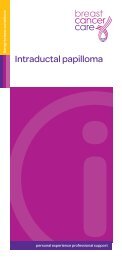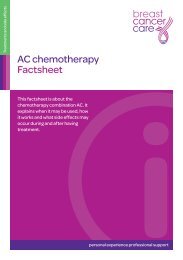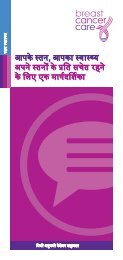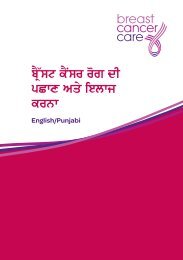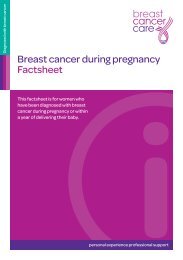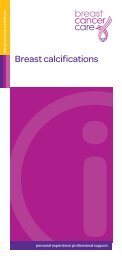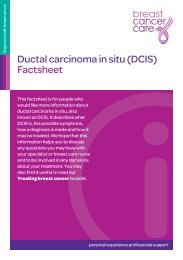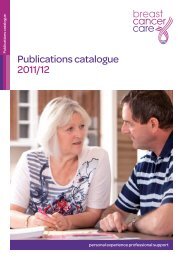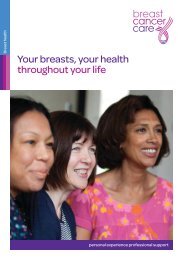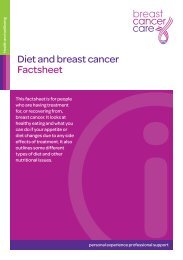Breast changes during and after pregnancy (BCC148) [PDF]
Breast changes during and after pregnancy (BCC148) [PDF]
Breast changes during and after pregnancy (BCC148) [PDF]
- No tags were found...
Create successful ePaper yourself
Turn your PDF publications into a flip-book with our unique Google optimized e-Paper software.
<strong>Breast</strong> <strong>changes</strong> <strong>during</strong><strong>and</strong> <strong>after</strong> <strong>pregnancy</strong>
<strong>Breast</strong> <strong>changes</strong> <strong>during</strong> <strong>and</strong> <strong>after</strong> <strong>pregnancy</strong> | 05IntroductionThis booklet looks at the <strong>changes</strong> that can happen toa woman’s breasts <strong>during</strong> <strong>pregnancy</strong> <strong>and</strong> <strong>after</strong> she hasher baby.The hormones released <strong>during</strong> <strong>pregnancy</strong> <strong>and</strong> <strong>after</strong> birth causelots of <strong>changes</strong> in a woman’s body. Some of these <strong>changes</strong>will be to a woman’s breasts as her body is preparing to feedher baby.We have tried to cover the main breast <strong>changes</strong> womenexperience <strong>during</strong> <strong>pregnancy</strong> but it is also important to continueto be breast aware at this time. Being breast aware is aboutbecoming familiar with your breasts <strong>and</strong> the way they changethroughout your life. It means knowing how your breasts look<strong>and</strong> feel normally so that you feel confident about noticing anychange that might be unusual for you. Sometimes this can bemore difficult <strong>during</strong> <strong>pregnancy</strong> because of normal <strong>changes</strong> tothe breasts at this time. If you are unsure about any change toyour breasts talk to your midwife or doctor.Call our Helpline on 0808 800 6000
<strong>Breast</strong> <strong>changes</strong> <strong>during</strong> <strong>and</strong> <strong>after</strong> <strong>pregnancy</strong> | 07What happens tothe breasts <strong>during</strong><strong>pregnancy</strong>?Changes to the breasts are one of the early signs of<strong>pregnancy</strong>. This may include tenderness of the nipple<strong>and</strong> breast along with an increase in breast size. Thisvaries from woman to woman <strong>and</strong> you may notice a bigchange in the size of your breasts or very little changeat all. An increase in size may make your breasts feelheavy <strong>and</strong> tender. The breast tissue extends up intothe armpit <strong>and</strong> some women with additional breasttissue (accessory breast tissue) may find that this alsogets bigger in size.Many women feel a change in sensation in their breasts suchas tingling <strong>and</strong> soreness (particularly of the nipples). This isdue to increased levels of the hormone progesterone <strong>and</strong> thedevelopment of the milk ducts. As your <strong>pregnancy</strong> progresses thenipples <strong>and</strong> areola become darker in colour <strong>and</strong> the veins on thesurface of the breast may become more noticeable.‘My breasts were an early sign of<strong>pregnancy</strong> for me. I increased several cupsizes <strong>and</strong> early on they were more tenderthan before. The tenderness subsidedquickly but they continued to grow <strong>during</strong><strong>pregnancy</strong> to an astounding size. I had tobuy a new bra twice <strong>during</strong> <strong>pregnancy</strong>.’JojoCall our Helpline on 0808 800 6000
08 | What happens to the breasts <strong>during</strong> <strong>pregnancy</strong>?The Montgomery gl<strong>and</strong>s get bigger <strong>and</strong> can become morenoticeable. From about 16 weeks of <strong>pregnancy</strong> the breasts areable to produce milk. It is not unusual for the nipples to leaksmall amounts of straw-coloured fluid known as colostrum. Thisis perfectly normal <strong>and</strong> not something to be concerned about.Colostrum is often called the ‘first milk’ <strong>and</strong> is full of nutrients <strong>and</strong>antibodies designed to provide the baby with additional protection<strong>during</strong> the first few days. If you are leaking colostrum <strong>and</strong> areworried that it may be noticeable on your clothes you can put abreast pad (a disposable or washable fabric pad) inside your bra.A few women may have occasional leakage of blood from thenipple. This is due to the increased number <strong>and</strong> sudden growth ofblood vessels. Although this can be normal <strong>during</strong> <strong>pregnancy</strong>, it isbest to get any leakage of blood from the nipple checked by yourGP (local doctor).In the last few weeks of <strong>pregnancy</strong> the nipples become larger<strong>and</strong> the breasts continue to exp<strong>and</strong> as the milk-producing cellsget bigger.‘I knew I might be pregnant when I hadvery tender breasts, especially atnight. It was this change that lead meto take a <strong>pregnancy</strong> test.’Emma‘My breasts were tender to touch butthat was the only real change. They didnot get larger until the third trimester.’LouiseVisit www.breastcancercare.org.uk
‘My breasts didn’t feel tender in the early stagesof <strong>pregnancy</strong>, but they definitely got bigger. Theyinitially went up a cup size <strong>and</strong> then from aboutweek 16 they were a couple of cup sizes larger.They also felt much more weighty.’Sanchia
10 | What happens to the breasts <strong>during</strong> <strong>pregnancy</strong>?<strong>Breast</strong> lumps<strong>Breast</strong> lumps sometimes occur <strong>during</strong> <strong>pregnancy</strong>. The mostcommon ones are cysts (fluid-filled sacs), galactoceles (milk-filledcysts) <strong>and</strong> fibroadenomas (fibrous tissue). If you already have afibroadenoma you may find this gets bigger <strong>during</strong> <strong>pregnancy</strong>.The vast majority of breast lumps in <strong>pregnancy</strong> will be benign(not cancer) as breast cancer in women of child-bearing ageis not common <strong>and</strong> even more uncommon <strong>during</strong> <strong>pregnancy</strong>.However, it is a good idea to get any new breast lump or growthof an existing lump checked out by your GP <strong>and</strong> to tell yourmidwife if you have an existing fibroadenoma, cyst or any otherbreast problem.<strong>Breast</strong> discomfortThe growth of the breasts can cause discomfort <strong>and</strong> sometimespain. This can be helped by wearing a well-fitting bra (seeopposite). It is fine to sleep in your bra if it helps reduce thediscomfort. You may find you don’t want to sleep on your front,although your growing bump may prevent this anyway. Pregnantwomen are usually advised to avoid taking certain types of painrelief, but if your breasts are particularly painful you may wantto take an appropriate dose of paracetomol. Talk to your GP ormidwife if you need further advice.Visit www.breastcancercare.org.uk
<strong>Breast</strong> <strong>changes</strong> <strong>during</strong> <strong>and</strong> <strong>after</strong> <strong>pregnancy</strong> | 11BrasAs your breasts grow you should check that your bra isn’t tootight which can cause discomfort. It is worth visiting a departmentstore or lingerie shop to be measured <strong>and</strong> to have your bra sizechecked by a trained bra fitter, or contact an NCT bra fitter (seethe ‘Further support’ section on page 38).A bra fits well if:• it’s not too tight or too loose• your breasts fill the cup of the bra leaving no loose fabric <strong>and</strong>contain the whole breast without any bulging at the top, bottomor sides• the strap at the back doesn’t cut in• the shoulder straps don’t carry the full weight of your breasts,stay in place when you lift your arms above your head, <strong>and</strong> fitclosely to your body without digging in• the strap round the back <strong>and</strong> the front underb<strong>and</strong> lie close toyour body <strong>and</strong> are at the same level at the front <strong>and</strong> back• with an underwired bra, the underwire lies flat against your body<strong>and</strong> supports the underneath <strong>and</strong> sides of your breast withoutdigging in or gaping.It is sometimes suggested that pregnant women shouldn’t wearunderwired bras as the wiring can sometimes cause blockagesin the milk ducts. However, there is no evidence to support this.As long as the bra fits you well <strong>and</strong> the wires of the bra aren’tdigging in, there is no reason to stop wearing an underwired bra.However, you may find it more comfortable to wear a maternity orsoft cup bra. These types of bras can also be worn in bed if youfeel you need extra support while sleeping.‘During my <strong>pregnancy</strong>, my breasts grew from a B cupto a D. They felt like they needed extra support whichled me to wearing a support bra in bed.’LeanneCall our Helpline on 0808 800 6000
12 | What happens to the breasts <strong>during</strong> <strong>pregnancy</strong>?If you are intending to breastfeed once your baby is born you maywant to buy a couple of nursing bras. These have cups whichunhook or unzip <strong>and</strong> make it easier to feed your baby. The besttime to be fitted for a nursing bra is a few weeks before yourdue date when your breasts will have done the majority of theirgrowing. If you go to a department store or lingerie shop to befitted for your nursing bra the fitter should take into account thatyour breasts will get even bigger when you start producing milk,but will probably settle down again later. The fitter will probablysuggest going up one or two cup sizes to allow for this. A widerange of bras are available from specialist maternity bra suppliers,by mail order <strong>and</strong> from department stores <strong>and</strong> lingerie shops.For more information on finding a bra that fits correctly see ourpublication, Your guide to a well-fitting bra.‘I would definitely recommend trying on as manymaternity bras as possible as there are loads ofdifferent styles <strong>and</strong> fits <strong>and</strong> it took me a while to findone I was comfortable in.’Sanchia‘I would tell all pregnant women to buy a few cottonmaternity bras from a specialist shop where theycan be measured <strong>and</strong> given specialised advice <strong>and</strong>information about <strong>pregnancy</strong> breast care.’Louise‘I had a new bra fitted at 10 weeks <strong>and</strong> planned toget refitted at 37 weeks, but my baby came early soI didn’t get fitted for a nursing bra until two weeks<strong>after</strong> the birth.’CatherineVisit www.breastcancercare.org.uk
‘I was fitted for my nursing bra the week before Igave birth <strong>and</strong> I was surprised at how well it fittedconsidering how much my breasts changed <strong>after</strong>childbirth. You need to shop around <strong>and</strong> findsomewhere you are happy with before childbirthas you won’t have time to do this <strong>after</strong>. I did findthe sales assistant’s advice very useful. Book anappointment <strong>and</strong> try lots of styles on.’Emma
14 | <strong>Breast</strong> <strong>changes</strong> <strong>after</strong> birth<strong>Breast</strong> <strong>changes</strong> <strong>after</strong> birthAfter childbirth oestrogen <strong>and</strong> progesterone levelsdecrease rapidly. Around the third day or so followingthe birth the colostrum becomes diluted by additionalfluid which makes it look much whiter. It is around thistime that the breasts start to leak milk.When a baby suckles at the mother’s breast it triggers nervescarrying messages to the brain that milk is needed. A hormoneknown as oxytocin is released from the brain to send milk to theducts behind the nipple. This is known as the ‘let down’ reflex.This let down reflex is very powerful <strong>and</strong> some women may findmilk leaks from the nipple when they hear their baby cry or if theirbreasts are full <strong>and</strong> they feel emotional.It can sometimes be embarrassing when you feel you can’tcontrol this reflex <strong>and</strong> you find you are leaking milk. This canhappen quite a lot in the first few days <strong>after</strong> you give birth, notjust when you are feeding. This reflex is perfectly normal <strong>and</strong> ifthis happens you could put breast pads in your bra to make youmore comfortable. You may also find wearing a sleep bra withbreast pads helpful.Oxytocin is released <strong>during</strong> each breastfeed <strong>and</strong> many womenexperience uterine contractions, sometimes known as <strong>after</strong>pains.The oxytocin causes these contractions <strong>and</strong> they help the uterusto return to its normal pre-<strong>pregnancy</strong> size. These <strong>after</strong>painsusually stop <strong>after</strong> a few days.‘Initially my breasts felt completely fine,then they became very heavy <strong>and</strong> likethey were going to explode!’RachelVisit www.breastcancercare.org.uk
<strong>Breast</strong> <strong>changes</strong> <strong>during</strong> <strong>and</strong> <strong>after</strong> <strong>pregnancy</strong> | 15‘My boobs remained large post giving birth but theshock was the milk coming in. I woke up on the sixthmorning with rock hard, painful <strong>and</strong> lumpy breasts thatleaked if you even touched them.’Jojo‘Once my milk had come in my breasts seemed rockhard. I sometimes needed to hold them when I wasgetting out of the bath.’Leanne‘Straight <strong>after</strong> the birth there wasn’t much change inthe feeling but by the second day I felt my breastsfilling. Once the baby fed the pressure was relieved.’Sarah‘I think everyone expects their breasts to get larger<strong>during</strong> <strong>pregnancy</strong>, but no-one can really prepare youfor the immense change when your milk comes in.They get huge <strong>and</strong> very hard! <strong>Breast</strong> pads were veryh<strong>and</strong>y to combat leakage.’Sanchia‘I have never had any soreness or painfrom “let down”. When my milk camein my breasts did feel very hard <strong>and</strong> alittle uncomfortable but nothing too bad. Imake sure I wear a bra in bed <strong>and</strong> luckilyI haven’t suffered from too much leakage!’CatherineCall our Helpline on 0808 800 6000
016 | Section titleVisit www.breastcancercare.org.uk
<strong>Breast</strong> <strong>changes</strong> <strong>during</strong> <strong>and</strong> <strong>after</strong> <strong>pregnancy</strong> | 17<strong>Breast</strong>feedingThe <strong>changes</strong> that happen to the breasts <strong>during</strong><strong>pregnancy</strong> are to prepare your breasts for feedinga baby. Whether or not you decide to breastfeedis entirely your decision. There is evidence to showthat breastfeeding has health benefits for both you<strong>and</strong> your baby. For example, breastfeeding over aperiod of time can slightly reduce your risk of breastcancer (however, this does depend on how long youbreastfeed for <strong>and</strong> other factors like your age <strong>and</strong> thenumber of children you have).The closeness <strong>and</strong> sense of satisfaction can also help you tobond with your baby. The benefits for your baby are that breastmilk contains antibodies that help fight infections. It is all the food<strong>and</strong> drink your baby needs in the early days. The Departmentof Health recommends exclusively breastfeeding for the first sixmonths of your baby’s life <strong>and</strong> then to continue breastfeedingalongside solid foods for as long as mother <strong>and</strong> baby wish.Although breastfeeding is a very natural process it cansometimes take a little time to get right <strong>and</strong> some womenfind it difficult. Encouraging the baby to attach to the breast‘All of the way through my <strong>pregnancy</strong> Iwas undecided about breastfeeding <strong>and</strong>really wanted to give it a go. But when Zackwas born I decided not to breastfeed. I’vehad breast cancer <strong>and</strong> it seemed cruelto look at this beautiful baby <strong>and</strong> see thescars. I suffered a huge amount of guilt for notbreastfeeding but looking back I am so pleased Ididn’t. I felt my breasts had been through enough.’AmberCall our Helpline on 0808 800 6000
18 | <strong>Breast</strong>feedingcorrectly is a learned skill. Some women are also anxious <strong>and</strong>concerned about their baby getting enough milk. Your midwifeor health visitor will be able to help you with breastfeeding <strong>and</strong>the different techniques you can use. There may also be abreastfeeding support group in your local area where you canshare your experiences with other mothers. Additionally, there areorganisations with trained breastfeeding counsellors that may beable to help. Some of these are listed at the back of this booklet.Some women choose not to breastfeed, either because it hasn’tbeen possible or they simply don’t feel it is the right choice forthem <strong>and</strong> their baby. There isn’t a right or wrong decision; youjust need to feel you have made the best decision for you <strong>and</strong>your baby.Women who have had breast surgery, for example breast cancer,breast reduction or breast implants, may find that they are unableto breastfeed. However, some women find that even <strong>after</strong> surgeryto the breast they are still able to breastfeed. Again, you may wantto ask your midwife, health visitor or breastfeeding counsellorfor help.‘I found breastfeeding much harder than I expected.Not knowing if your baby is having enough, theconstant feeding, fitting in time to express so mymilk supply increased, no-one can really prepare youfor it <strong>and</strong> I am not surprised that so many women can’tcontinue. I am glad I persevered but almost every dayI was thinking “is today the day we try formula?”’CatherineVisit www.breastcancercare.org.uk
‘I found local breastfeeding support groups/coffeemornings very helpful in swapping stories, advice,tips <strong>and</strong> stories about sleepless nights.’Emma
20 | <strong>Breast</strong>feeding‘<strong>Breast</strong>feeding was a relief from the full boobs but itwas also painful for a good six weeks. I persevered forvarious reasons <strong>and</strong> in the end it was relatively easy forthe four months I did it.’Jojo‘I have had a very positive experience breastfeeding,with no problems so far (almost seven months in) <strong>and</strong>a baby who latched on excellently.’Rachel‘I had no problems breastfeeding but I know that thisisn’t the case for a lot of women. Although the benefitsto the baby are well documented, very little is saidabout mums. I found it exhausting at times, it isdem<strong>and</strong>ing <strong>and</strong> constant. I had two very hungrybabies, so produced a lot of milk. My breasts wouldleak very quickly if they hadn’t fed.’Donna‘I didn’t want to breastfeed for a variety of reasons <strong>and</strong>was relieved that I couldn’t in the end (I was poorly withpre-eclampsia). I’m very comfortable with my decision<strong>and</strong> probably won’t breastfeed next time, althoughagain I’ll probably do a couple of days so my baby getsthe colostrum.’BeccaVisit www.breastcancercare.org.uk
‘I would advise women to persevere withbreastfeeding if they find it difficult at first,<strong>and</strong> would definitely speak to a breastfeedingcounsellor before quitting as it does get so mucheasier with time.’Sanchia
<strong>Breast</strong> <strong>changes</strong> <strong>during</strong> <strong>and</strong> <strong>after</strong> <strong>pregnancy</strong> | 23Possible breast problemsThis section looks at what happens when your milk‘comes in’ <strong>and</strong> any problems you may experience.The following information may apply to women whobreastfeed <strong>and</strong> women who have decided not to <strong>and</strong>want to stop their milk supply.It is not unusual to experience some problems with your breastswhen your breast milk comes in <strong>and</strong> in the first few weeks<strong>after</strong>wards. Many of these problems are caused by inflammationor infection of the breast. However, many women don’texperience problems at all.‘I did read a lot of literature before childbirth aboutpotential breast problems. I was very fortunate thatI didn’t experience any problems at all, however, Ido feel it’s worth knowing about what could happen<strong>and</strong> how to deal with it so you are prepared ifproblems occur.’EmmaCall our Helpline on 0808 800 6000
24 | Possible breast problemsSore <strong>and</strong> cracked nipplesSore <strong>and</strong> cracked nipples are not an inevitable part ofbreastfeeding. They occur if the baby is not latched on correctly.If the baby sucks the nipple only rather than the whole areolabeing in the mouth, the nipples can quickly become sore <strong>and</strong>sometimes cracked because the baby’s tongue or roof of themouth is rubbing on the nipple. It is important to ask for support<strong>and</strong> advice from a midwife or breastfeeding counsellor if feedingis in any way painful. National breastfeeding helplines are detailedat the end of this booklet. If one breast is less sore, try to feedfrom that one first, so that if you need to swap to the other breastthe baby will feed less strongly.Some women find nipple shields useful if their nipples are verysore. These are made of thin, soft silicone <strong>and</strong> can be placedover the nipple. Milk flows to the baby from holes at the tip of theshield. Using nipple shields sometimes allows time for the nipplesto heal. However, they don’t work for everyone <strong>and</strong> some babieswill refuse to feed through a nipple shield or may refuse to goback to feeding directly from the breast without one.Visit www.breastcancercare.org.uk
<strong>Breast</strong> <strong>changes</strong> <strong>during</strong> <strong>and</strong> <strong>after</strong> <strong>pregnancy</strong> | 25‘I found breastfeeding reasonably easy but did stillexperience sore nipples in the first couple of weeks<strong>and</strong> even had a scab on my nipple at one point wheremy baby wasn’t latching on properly. I’m very glad Ipersevered as it got easier day by day. A nipple barriercream is a must!’Sanchia‘I was determined to breastfeed. I did find it muchharder than I had ever anticipated it to be. Myinstinct told me that my baby wasn’t latching onproperly so I attended a breastfeeding workshopat the hospital where I was shown the correct wayto get my baby to latch on <strong>and</strong> which helped usmassively <strong>and</strong> reassured me.’Emma‘I really wanted to breastfeed Herbie but I found it alot more difficult than I anticipated. I had invertednipples which made it more difficult from the off.The midwives were really helpful but I left hospitalrelying on feeding my son with a nipple shield.’LouiseCall our Helpline on 0808 800 6000
26 | Possible breast problemsEngorgement<strong>Breast</strong> engorgement is over-fullness of the breast <strong>and</strong> is acommon problem. Approximately two to three days <strong>after</strong> givingbirth the woman’s breasts fill with milk <strong>and</strong> as part of this thebreasts become heavy <strong>and</strong> swollen. <strong>Breast</strong> engorgement occursif the baby removes less milk from the breast when feedingthan the amount that the mother produces. Some women havedescribed their breasts as feeling hard, warm <strong>and</strong> throbbing.<strong>Breast</strong> engorgement generally happens <strong>after</strong> the first few dayswhen the milk first comes into the breasts or later on when thereis a longer time between feeds. It can also happen if the breastsare not fully emptied, if the baby is having difficulty attachingto the breast or if you have decided not to breastfeed or ifbreastfeeding is suddenly stopped.If you are continuing to breastfeed, engorgement can be treatedby feeding on dem<strong>and</strong> <strong>and</strong> altering the feeding position to ensurethe breast is being fully emptied. If the baby is not able to emptythe breast you may find it useful to express by h<strong>and</strong> or pump themilk away using a breast pump (these can either be electronicor h<strong>and</strong> held). Your midwife, health visitor or a breastfeedingcounsellor will be able to show you how to h<strong>and</strong> express.Some women have found massaging the breast in a circularmotion down to the nipple as the baby feeds useful in ensuringthe breast is fully emptied. Other women have found placing icepacks (covered with a towel or flannel) on the breast <strong>after</strong> feedinghelpful in reducing the swelling.Visit www.breastcancercare.org.uk
<strong>Breast</strong> <strong>changes</strong> <strong>during</strong> <strong>and</strong> <strong>after</strong> <strong>pregnancy</strong> | 27‘I had very engorged breasts in the early days which Imanaged to soothe with hot flannels <strong>and</strong> paracetamol.A hot shower or bath also helped as it caused some ofthe milk to leak out which eased the pressure.’Sanchia‘I generally relieved engorgement by expressing orfeeding the baby so it gradually corrected itselfalthough if I missed a feed it would return.’Jojo‘I experienced some engorgement initially, but it wentif I fed my baby or had a bath.’RachelCall our Helpline on 0808 800 6000
28 | Possible breast problemsBlocked milk ductsSometimes a milk duct within the breast may become blockedwhile breastfeeding. This can also occur once breastfeeding hasstopped. You may experience a small, painful, hard lump or abruised feeling. Feeding the baby more often <strong>and</strong> a change ofposition may help to drain the area more fully. Gently massagingthe lump towards the nipple before feeding can help clear it.Applying warm flannels to the breast has also been helpful formany women. You may also want to ensure that your bra isn’t tootight as this can also cause blocked ducts.‘I had a sore right breast on a couple of occasionswhich I put down to a slightly blocked milk duct asan area of breast went red <strong>and</strong> felt very hard. Again Iused a hot compress on it <strong>and</strong> made sure my baby fedmore on that side to draw the blockage out. It was allfine within a day or so, but was very tender <strong>and</strong> painfulat the time.’SanchiaVisit www.breastcancercare.org.uk
<strong>Breast</strong> <strong>changes</strong> <strong>during</strong> <strong>and</strong> <strong>after</strong> <strong>pregnancy</strong> | 29MastitisIf engorgement or blockage to the ducts continues, aninflammation or infection may occur. This is known as mastitis. Itmay also occur because of an infection from a crack or graze inthe nipple. It causes flu-like symptoms such as headache, nausea<strong>and</strong> a raised temperature. If you think you may have mastitisyou will need to see your doctor as it may need treating withantibiotics or anti-inflammatory drugs.Continuing to breastfeed frequently helps to clear the infection<strong>and</strong> is not harmful to the baby as any bacteria are killed in thebaby’s stomach. Expressing milk either by h<strong>and</strong> or by using abreast pump may help ensure the breast has been fully emptied.Before feeding, applying a flannel soaked in warm water to theaffected area of the breast may help stimulate the milk flow.Following feeding, ice packs applied to the breast may ease theswelling <strong>and</strong> discomfort, but make sure you cover the pack witha flannel or towel to protect your skin. Drinking plenty of fluidswill also help, as will getting enough rest, although this may bedifficult with a new baby to care for. Accept any offers of help<strong>and</strong> try to take opportunities to rest when you can.‘I had mastitis <strong>and</strong> first of all rested <strong>and</strong> tried tomassage away the swelling, but it didn’t work. I gotmore <strong>and</strong> more tired <strong>and</strong> the pain was awful. I wentto the doctors who prescribed antibiotics whichsorted it out pretty quickly.’KarenCall our Helpline on 0808 800 6000
30 | Possible breast problems<strong>Breast</strong> abscessIf mastitis or an infection isn’t treated some women go on todevelop an abscess (a collection of pus) in the breast. <strong>Breast</strong>abscesses are not common – if you think you have an abscessit is very important to see your doctor. Abscesses are usuallydrained using a needle <strong>and</strong> syringe.Your GP may be able to do this but it is more likely that you will bereferred to your local hospital for this to be done in a breast clinic.If the abscess is large, a small cut is made in it to let the pus drainaway. Often an injection of local anaesthetic is given to numb thearea first.As with mastitis it is important to remove the infected milkregularly <strong>and</strong> you can do this through continuing to feed thebaby or by using a breast pump to express the milk. However,sometimes the baby may not want to feed due to the change inthe taste of the milk (due to the infection). You can continue tobreastfeed as normal from the unaffected breast.Visit www.breastcancercare.org.uk
<strong>Breast</strong> <strong>changes</strong> <strong>during</strong> <strong>and</strong> <strong>after</strong> <strong>pregnancy</strong> | 31ThrushThrush (c<strong>and</strong>ida albicans) is a yeast infection that may occur onthe nipple <strong>and</strong> areola <strong>during</strong> breastfeeding. This can happensuddenly even when pain-free breastfeeding has been wellestablished. It can also take place following cracking or damageto the nipple. The nipple may become itchy, painful <strong>and</strong> sensitiveto touch.Some women find they have shooting pains deep in the breastthat start <strong>after</strong> feeding <strong>and</strong> can last for a few hours. If the pain isparticularly severe it may mean that the thrush has got into themilk ducts.Thrush can be difficult to distinguish as many of the signs of it aresimilar to those caused by the baby not being latched on to thebreast properly <strong>during</strong> breastfeeding (see section on ‘Sore <strong>and</strong>cracked nipples’).Thrush can also be passed from mother to baby. Signs of thrushin your baby may include a creamy patch on the tongue or in themouth which does not rub off, restlessness <strong>during</strong> feeding, pullingaway from the breast <strong>and</strong> nappy rash (red rash or soreness that isslow to heal).You may find you need to take pain relief to ease the pain causedby thrush. Both you <strong>and</strong> your baby will need to have treatment atthe same time. Your GP will be able to prescribe creams or gels toapply to the nipple area following each feed along with a gel for thebaby’s mouth. You may also need to take tablets if the thrush hasaffected the ducts. It may take two or three days for the treatmentto start working <strong>and</strong> a little while for it to clear up completely.Some women find practical solutions can be helpful in settlingthrush. Maintaining good hygiene <strong>and</strong> using a separate towel willhelp prevent spreading the thrush to other family members. If youhave expressed milk <strong>and</strong> stored it in the freezer <strong>during</strong> the time youor your baby have thrush, it is best to throw this away as it maycause the thrush to come back. However, you can continueto breastfeed.Call our Helpline on 0808 800 6000
<strong>Breast</strong> <strong>changes</strong> <strong>during</strong> <strong>and</strong> <strong>after</strong> <strong>pregnancy</strong> | 33What happens if Idon’t breastfeed, orwant to stop?Women continue to produce milk as long asbreastfeeding continues. Once you have stopped itmay take some time for the milk production to stopcompletely. In the first few days <strong>after</strong> birth the milkstops very quickly, but later, if breastfeeding has beenestablished, it takes longer.When breastfeeding stops the breasts will slowly reduce in size.If you choose not to breastfeed <strong>and</strong> no milk is being removed achemical signal will quickly stop more milk being made <strong>and</strong> themilk production will stop. In the meantime, you will probably findthat your breasts feel heavy, uncomfortable <strong>and</strong> sore. Sometimesthis can lead to engorgement (see page 26). Wearing a supportivebra <strong>and</strong> taking pain relief may help <strong>during</strong> these first few days.If you have been breastfeeding <strong>and</strong> want to stop you cangradually reduce the length <strong>and</strong> number of your breastfeeds.This will naturally allow the production of milk to reduce. You canalso express the milk by h<strong>and</strong> or by using a breast pump. Youwill need to do this frequently to begin with <strong>and</strong> then reduce itgradually over a number of days. Your body produces milk on asupply <strong>and</strong> dem<strong>and</strong> basis so if you express milk less <strong>and</strong> lessover time your body won’t replace it. You may find it best not tostop too quickly, as this can lead to engorgement. Milk may leakfor several weeks <strong>after</strong> stopping if something triggers the‘let down’ reflex.Call our Helpline on 0808 800 6000
34 | What happens if I don’t breastfeed, or want to stop?Many women continue breastfeeding while going back to work.You may want to build up to working again gradually <strong>and</strong> possiblynegotiate with your employer flexible working hours in order tocombine work <strong>and</strong> breastfeeding. Expressing milk using a breastpump may be another option so that someone else can feed yourbaby while you’re at work. If you have a Human Resources (HR)department, they may be able to help you prepare for your returnto work. It may be possible to give you a private room, where youcan express your milk or breastfeed your baby.‘When I stopped breastfeeding, engorgementwas the worst side effect so I tried to express verysmall amounts to relieve it but avoid stimulatingdem<strong>and</strong>. Because my son had refused the bottlebefore the transition was aggressive from 100%breast to 100% bottle all at once so I did have tomanage the expressing <strong>after</strong>wards.’Jojo‘I stopped breastfeeding Herbie when he was sixweeks old <strong>and</strong> for me it was the right decision. He wasa lot happier <strong>and</strong> so was I! I did not have any problemswith full breasts as I regularly expressed.’Louise‘As I had experienced problems breastfeeding I alsoused formula. I never experienced pain or discomfortwhen I completely stopped breastfeeding as I hadreduced over a long period.’LeanneVisit www.breastcancercare.org.uk
<strong>Breast</strong> <strong>changes</strong> <strong>during</strong> <strong>and</strong> <strong>after</strong> <strong>pregnancy</strong> | 35‘My little girl was just over a year old when I stoppedbreastfeeding. About six weeks before I cut herbreastfeeds down to one in the morning <strong>and</strong> one inthe evening then <strong>after</strong> three weeks of doing this I justbreastfed her once in the morning. By the time westopped I had no engorgement.’Sarah‘I had pre-eclampsia so they had to test Oliver<strong>after</strong> every feed I did in the hospital to make surehe wasn’t getting my medication. After two daysof breastfeeding the colostrum enough wasenough – he was losing a lot of weight <strong>and</strong> I was soweak. Even the midwives said it was probably bestI stop. My milk vanished quickly <strong>and</strong> I only had oneengorgement episode.’BeccaCall our Helpline on 0808 800 6000
<strong>Breast</strong> <strong>changes</strong> <strong>during</strong> <strong>and</strong> <strong>after</strong> <strong>pregnancy</strong> | 37Your breasts <strong>after</strong><strong>pregnancy</strong>After <strong>pregnancy</strong>, whether you have breastfed or not,your breasts probably won’t look or feel the same asthey used to. You may have put on weight or lost weight.It is not unusual to find your breasts have altered insize <strong>and</strong> shape compared with before <strong>pregnancy</strong>. If youhave breastfed you may have lost some of the volumein your breasts. Some women don’t like the <strong>changes</strong>to their breasts post-<strong>pregnancy</strong> while others acceptthe <strong>changes</strong> to their breasts as they have played animportant part in their child’s early days.All these <strong>changes</strong> are normal <strong>and</strong> are part of the <strong>changes</strong> yourbreasts go through at different stages in life. It is important thatyou get to know how your breasts now look <strong>and</strong> feel so you canbe aware of any new <strong>changes</strong>. You can find out more aboutbreast awareness from our Your breasts, your health leaflets.Call our Helpline on 0808 800 6000
38 | Further supportFurther support<strong>Breast</strong>feeding Network (BfN)PO Box 11126, Paisley PA2 8YBSupport line: 0300 100 0210Email: enquiries-2011@breastfeedingnetwork.org.ukWebsite: www.breastfeedingnetwork.org.ukThe <strong>Breast</strong>feeding Network aims to be an independent sourceof support <strong>and</strong> information for breastfeeding women <strong>and</strong> others.It has a breastfeeding support line <strong>and</strong> breastfeeding supportcentres across the UK.La Leche League GBPO Box 29, West Bridgford,Nottingham NG2 7NPOffice: 0845 456 1855<strong>Breast</strong>feeding helpline: 0845 120 2918Website: www.laleche.org.ukLa Leche League GB is affiliated to La Leche LeagueInternational, a voluntary organisation dedicated to providingeducation, information, support <strong>and</strong> encouragement to womenwho want to breastfeed. Services include a telephone helpline<strong>and</strong> local support groups for breastfeeding mothers.Visit www.breastcancercare.org.uk
<strong>Breast</strong> <strong>changes</strong> <strong>during</strong> <strong>and</strong> <strong>after</strong> <strong>pregnancy</strong> | 39NCT (The National Childbirth Trust)Alex<strong>and</strong>ra House, Oldham Terrace,Acton, London W3 6NHEnquiries: 0300 330 0770Pregnancy <strong>and</strong> birth line: 0300 330 0772<strong>Breast</strong>feeding support line: 0300 330 0771Website: www.nct.org.ukCharity concerned with <strong>pregnancy</strong>, birth <strong>and</strong> parenting in theUK. Membership organisation with over 100,000 members.Includes a network of volunteers <strong>and</strong> branches who provide <strong>and</strong>support local services, training <strong>and</strong> evidence-based informationfor parents, families <strong>and</strong> health professionals. Has dedicatedhelplines for <strong>pregnancy</strong>, birth <strong>and</strong> breastfeeding enquiries. Alsoprovides antenatal <strong>and</strong> postnatal classes.UNICEF – The Baby Friendly InitiativeWebsite: www.babyfriendly.org.ukThe Baby Friendly Initiative is a worldwide programme of theWorld Health Organisation <strong>and</strong> UNICEF. It was launched in 1992to encourage maternity hospitals to implement the Ten Stepsto Successful <strong>Breast</strong>feeding <strong>and</strong> to practise in accordance withthe International Code of Marketing of <strong>Breast</strong>milk Substitutes.Produces information on breastfeeding.Call our Helpline on 0808 800 6000
40 | NotesNotesVisit www.breastcancercare.org.uk
<strong>Breast</strong> <strong>changes</strong> <strong>during</strong> <strong>and</strong> <strong>after</strong> <strong>pregnancy</strong> | 41NotesCall our Helpline on 0808 800 6000
42 | NotesNotesVisit www.breastcancercare.org.uk
This booklet can be downloaded from our website,www.breastcancercare.org.ukIt is also available in large print, DAISY format, Braille oron audio CD on request by phoning 0845 092 0808.This booklet has been produced by <strong>Breast</strong> CancerCare’s clinical specialists <strong>and</strong> reviewed by healthcareprofessionals <strong>and</strong> members of the public.If you would like a list of the sources we used to researchthis publication, email publications@breastcancercare.org.uk or call 0845 092 0808.CentresLondon <strong>and</strong> the South East of Engl<strong>and</strong>Telephone 0845 077 1895Email src@breastcancercare.org.ukWales, South West <strong>and</strong> Central Engl<strong>and</strong>Telephone 0845 077 1894Email cym@breastcancercare.org.ukEast Midl<strong>and</strong>s <strong>and</strong> the North of Engl<strong>and</strong>Telephone 0845 077 1893Email nrc@breastcancercare.org.ukScotl<strong>and</strong> <strong>and</strong> Northern Irel<strong>and</strong>Telephone 0845 077 1892Email sco@breastcancercare.org.uk© All rights are reserved. No part of this publication may be reproduced, stored or transmitted,in any form or by any means, without the prior permission of the publishers.Stock images ©ImageSource.com pages 16, 22, 32. ©istockphoto/digitalskillet page 04.
<strong>Breast</strong> Cancer Care is here for anyone affected by breastcancer. We bring people together, provide information <strong>and</strong>support, <strong>and</strong> campaign for improved st<strong>and</strong>ards of care.We use our underst<strong>and</strong>ing of people’s experience of breastcancer <strong>and</strong> our clinical expertise in everything we do.We promote the importance of early detection of breastcancer <strong>and</strong> provide accurate answers to questions aboutbreast health. We believe that up-to-date information,based on clinical evidence, builds confidence <strong>and</strong> helpspeople take control of their health. Our training, workshops<strong>and</strong> resources explain how to be breast aware <strong>and</strong> what<strong>changes</strong> to look <strong>and</strong> feel for.Visit www.breastcancercare.org.uk or call ourfree Helpline on 0808 800 6000 (Text Relay 18001).Interpreters are available in any language. Calls may be monitored for trainingpurposes. Confidentiality is maintained between callers <strong>and</strong> <strong>Breast</strong> Cancer Care.Central Office<strong>Breast</strong> Cancer Care5–13 Great Suffolk StreetLondon SE1 0NSTelephone 0845 092 0800Fax 0845 092 0820Email info@breastcancercare.org.uk© <strong>Breast</strong> Cancer Care, March 2012, <strong>BCC148</strong>ISBN 978 1 907001 70 3Edition 3, next planned review 2014Registered charity in Engl<strong>and</strong> <strong>and</strong> Wales (1017658)Registered charity in Scotl<strong>and</strong> (SC038104)Registered company in Engl<strong>and</strong> (2447182)


![Breast changes during and after pregnancy (BCC148) [PDF]](https://img.yumpu.com/46763758/1/500x640/breast-changes-during-and-after-pregnancy-bcc148-pdf.jpg)
